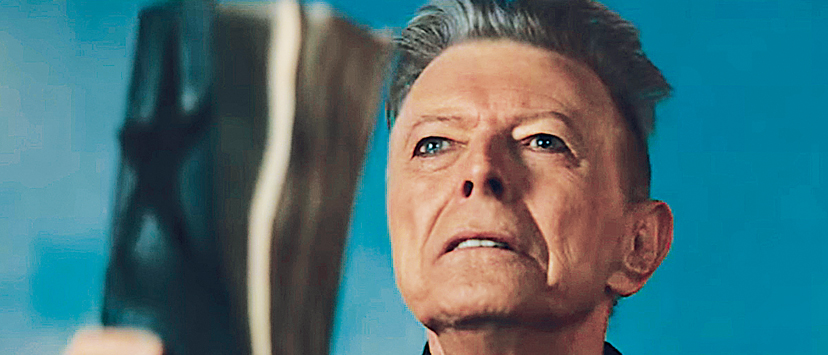
David Bowie’s videos for “Blackstar” and “Lazarus” — which I saw for the first time a week ago, to fulfill a promise to my niece — have officially freaked me out. I’m really mental over them. I’ve watched them every day for the past week, and in that time, I’ve had three dreams about death. A loved one asked me to stop watching the videos. But I feel I must see this thing through, in order to receive, and comprehend, all of the important messages that are trying to make themselves known to me. (Like: Take care of yourself, asshole, and maybe you’ll live longer.) Besides, we Irish love it when a song or a play or a poem has the power to coax a tear.
 Like most people old enough to have purchased “Ziggy Stardust” when it first appeared in record shops, I’ve been contemplating my mortality with growing frequency and intensity. “Blackstar” and “Lazarus” are from Bowie’s final album, also titled “Blackstar,” which was released on the singer’s 69th birthday, Jan. 8, 2015, two days before his death from liver cancer. Bowie is very honest — blunt, even — in contemplating the inevitable in the lyrics and imagery of these videos.
Like most people old enough to have purchased “Ziggy Stardust” when it first appeared in record shops, I’ve been contemplating my mortality with growing frequency and intensity. “Blackstar” and “Lazarus” are from Bowie’s final album, also titled “Blackstar,” which was released on the singer’s 69th birthday, Jan. 8, 2015, two days before his death from liver cancer. Bowie is very honest — blunt, even — in contemplating the inevitable in the lyrics and imagery of these videos.
But it’s not all sad. We are watching a dying man create art. “A parting gift” is what Tony Visconti — who produced “Blackstar” and 12 other Bowie albums, including “The Man Who Sold the World” and “David Live”— called “Blackstar.” Bowie essentially dragged himself out of his deathbed to create this art, and despite the cancer (and treatment) that ravaged his body, the old Bowie — with his magic, his cleverness, his vocal gifts, his rock-star aura, even his glamour — re-emerged.
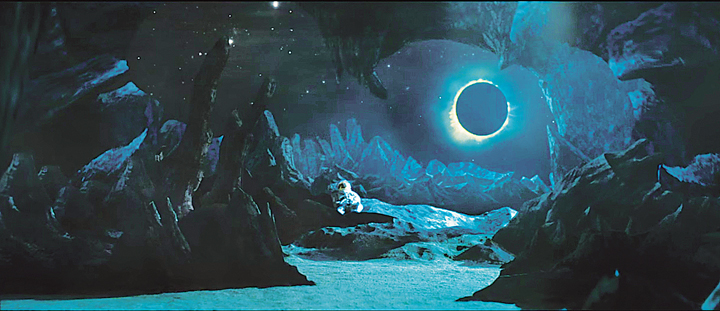
“Blackstar,” the video, opens on an alien world, on which we see the remains of an astronaut. The video is something like a sci-fi movie, which is not out of character for Bowie. Think of “Space Oddity” (a song Visconti produced way back in 1970), and “Starman” from “Ziggy,” not to mention the 1976 film “The Man Who Fell to Earth.” The video was helmed by Johan Renck, the Swedish director of a French miniseries, “The Last Panthers,” which uses an edited and enhanced version of “Blackstar” as its opening theme. Bowie’s trust in Renck was not misplaced.
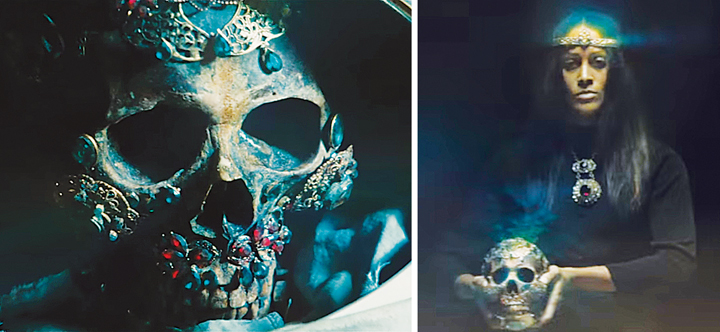
Along strolls a beautiful young woman (British actress Elisa Lasowski), who is a native of this planet — the “unibrow” and the Navi-style tail are the giveaway. She opens the astronaut’s helmet to reveal a jeweled skull. She later brings the skull to a group of village women for a strange ritual. I believe the skull somehow imbues her with power and nobility. Just a theory. “Blackstar” raises more questions than it answers.
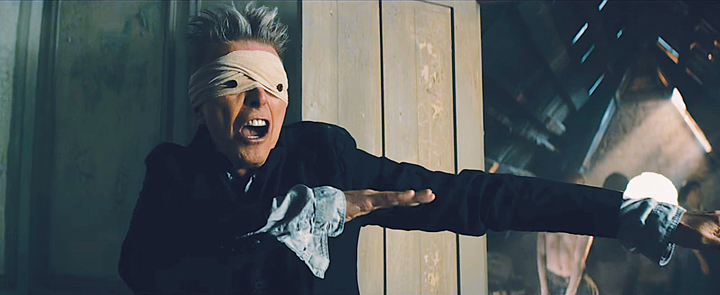
Bowie is first seen as a desperate character whose eyes are covered by a bandage with two small metal buttons. The character is called “Button Eyes” on imdb, which reminds me of Eugene Field’s creepy children’s poem, “Lady Button-Eyes.” Bowie sings: “On the day of execution …” which makes you ponder how cancer is an executioner.
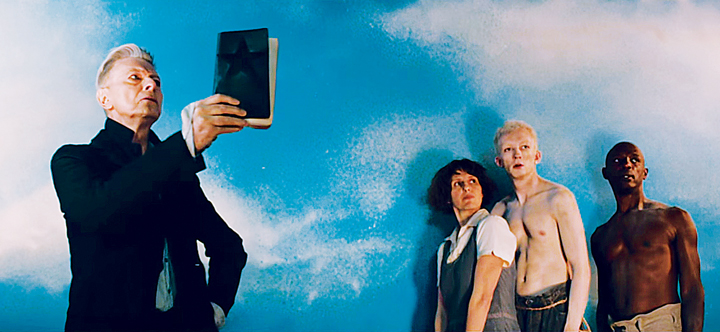
On my first viewing, I figured Bowie was singing weird, looking weird and moving weird because he was working around, or outright concealing, his illness. (I should have known better: Bowie never needed an excuse to sing, look or move weird.) As I watched, I was beginning to doubt we would see his eyes in this video. Then came a gorgeous sequence in which he is holding up a book with a black star on its cover, somehow controlling light and, I believe, the ether itself. His eyes seem to be looking beyond space and time. This sequence took my breath away for a moment.
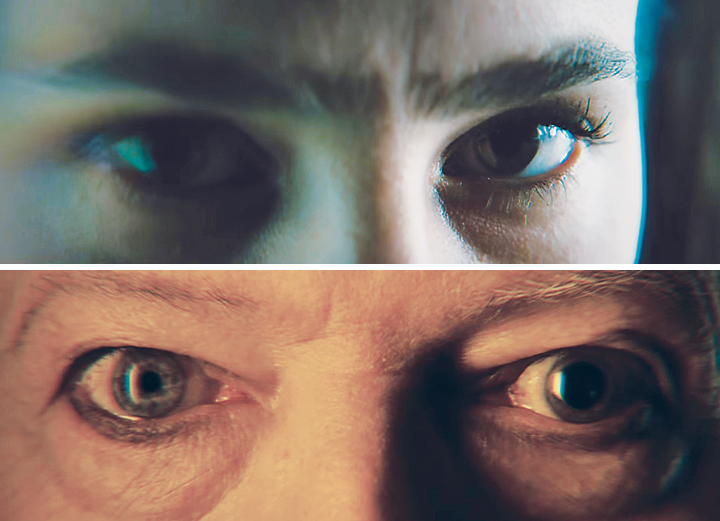
How wrong I was about the eyes! The beautiful bridge — “Something happened on the day he died” — has an adorable sequence with tight close-ups of Lasowski’s and Bowie’s eyes. She is being flirty and playful. Bowie’s eyes are clearly those of a sick man (albeit, one who has kept up with his eyebrow maintenence). They register no express emotion, with the possible exception of confusion. This all sounds wrong on paper, but it plays beautifully. I don’t believe Lasowski’s and Bowie’s characters are communicating here; I chalk it up to ironic intercutting by Renck. It’s an interlude distinct from the narrative — a bit of whimsy that works with the melody, if not the “story.” Some light in the darkness.
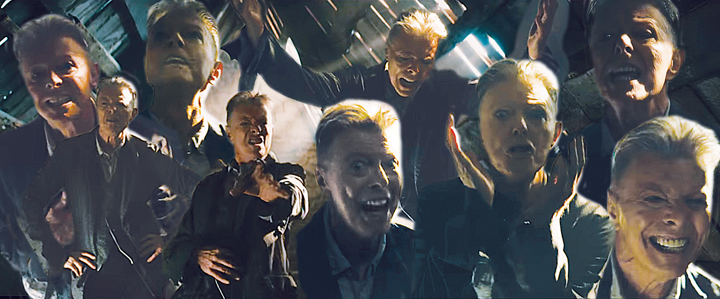
The bestest part has Bowie — the real Bowie, our Bowie — in what looks like a dusty, erratically lit attic. He’s singing slinky rock: “I’m-a take you home / take your passport and shoes / and your sedatives, boo …” It fills your heart with joy to see Bowie break out his rock-star moves. I created the above collage to show you some highlights of the sequence. (Apparently, I have a lot of time on my hands.)

I only wish these guys — three blindfolded, gyrating human scarecrows, crudely crucified in a field — never showed up in this video. They disturb me, they stress me out, and they ruin the moment for me. (But then again, death ruins the moment.) Here, “Blackstar” suddenly becomes a horror movie. We’ve seen stuff like this in any number of horror flicks from “The Texas Chainsaw Massacre” to “Motel Hell.” I’m especially creeped out by the fat guy in the middle. (And, yes, symbolism seekers, when Jesus Christ was crucified, there were two dudes on either side of him, likewise hanging on crosses.)
VIDEO: Above is the “Blackstar” video. It blew my mind, in case I haven’t made that clear. Watching Bowie create art in his final months is further proof of the indomitable human spirit. And it makes me miss Bowie so deeply that it causes real anguish.
P.S.: I plan to write about the “Lazarus” video, which also has mind-blowing symbolism and a glorious performance by Bowie, before I die.